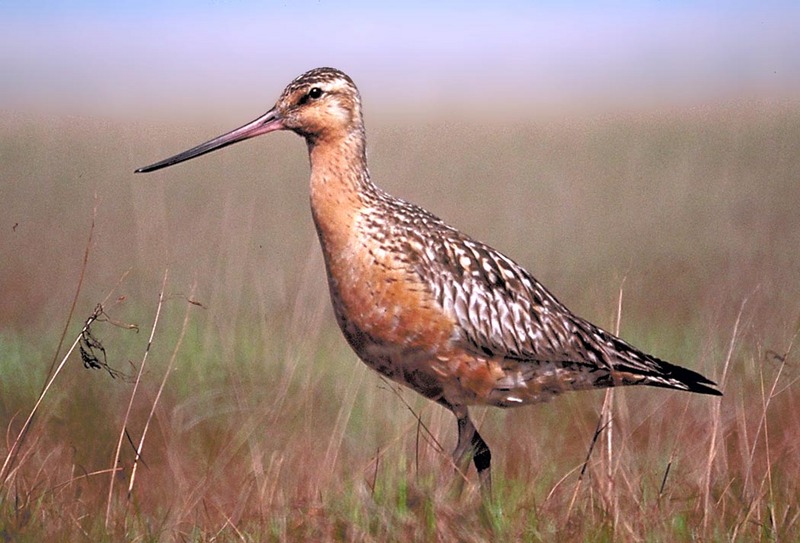Bar-tailed Godwit
From Wikipedia, the free encyclopedia
[Photo] Bar-tailed Godwit, Limosa lapponica. From The U.S. Fish & Wildlife Service.
The Bar-tailed Godwit, Limosa lapponica, is a large shorebird from the family Scolopacidae. This species makes the longest non-stop flight known for any bird and also the longest journey without pausing to feed by any animal: 11,000 km from Alaska to New Zealand (BTO News 258: 3, 2005).
Description
It is a relatively short-legged member of the godwit genus.
Adults have blue-grey legs and a very long dark bill with a slight upward curve and pink at the tip. The neck, breast and belly are unbroken brick red in breeding plumage, off white in winter. The back is mottled grey.
They are distinguished from Black-tailed Godwit by their barred, rather than wholly black, tails and a lack of white wing bars. The most similar species is the rare Asiatic Dowitcher.
Diet
These birds forage by probing on mudflats or in marshes. In short vegetation, they may pick up insects by sight. They mainly eat insects and crustaceans, but also eat parts of aquatic plants.
Breeding
Their breeding habitat is Arctic Asia and western Alaska on open tundra. They nest on the ground, usually in short vegetation.
Migrations
They migrate in flocks to coastal western Europe, Africa, South Asia, Australia and New Zealand - where the sub-species Limosa lapponica baueri is called K??aka in M??ori.
Bar-tailed Godwits have recently (March 2007) been shown to undertake the longest non-stop flight of any bird. Using satellite tracking, birds in New Zealand were tagged and tracked all the way to the Yellow Sea in China. According to Dr. Clive Minton (Australasian Wader Studies Group) "The distance between these two locations is 9,575 km, but the actual track flown by the bird was 11,026 km. This is the longest known non-stop flight of any bird. The flight took approximately nine days. At least three other Bar-tailed Godwits also appear to have reached the Yellow Sea after non-stop flights from New Zealand."
Stray birds from Europe and Asia occasionally appear on both North American coasts.
Protection
The Bar-tailed Godwit is one of the species to which the Agreement on the Conservation of African-Eurasian Migratory Waterbirds (AEWA) applies.
http://en.wikipedia.org/wiki/Bar-tailed_Godwit
| The text in this page is based on the copyrighted Wikipedia article shown in above URL. It is used under the GNU Free Documentation License. You may redistribute it, verbatim or modified, providing that you comply with the terms of the GFDL. |
|

